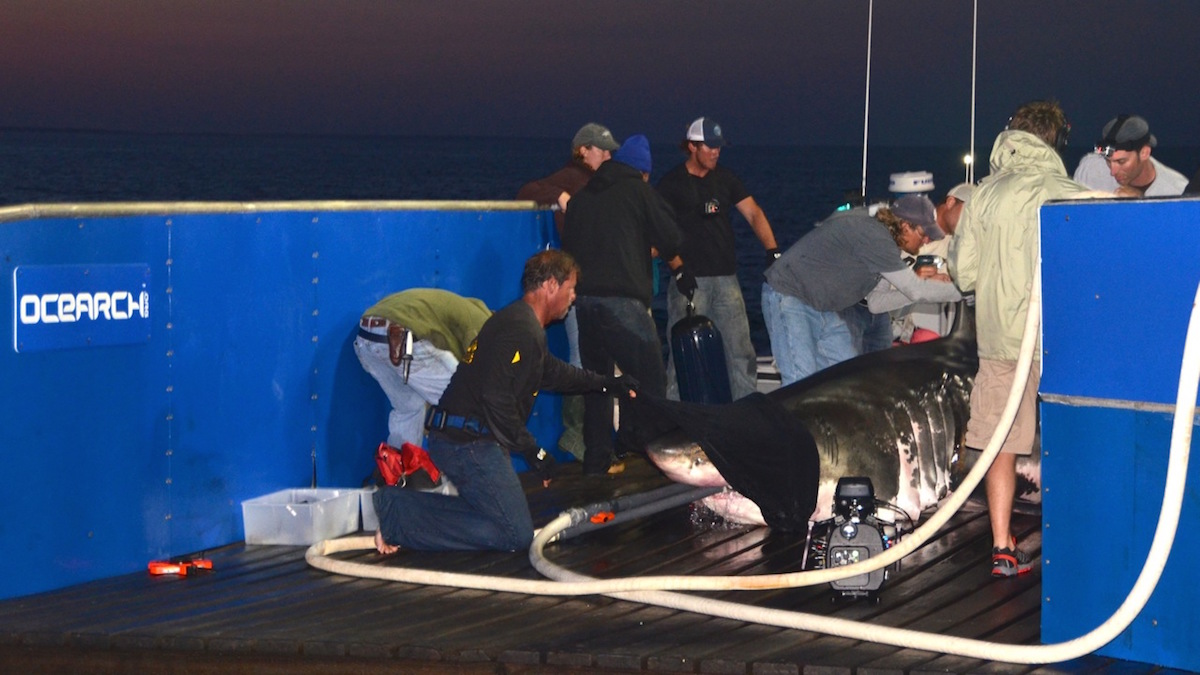The Imperfect Science of Determining How Old A Great White Shark Is

Mary Lee is tagged and studied off the coast of Cape Cod. Via OCEARCH
We know a lot about Mary Lee. We know that since September 17, 2012, when she was tagged in the nearby waters of Cape Cod, the 16-foot-long Great White shark has swum 20,168 miles. We know that she weighs 3,456 pounds. We know she has 66,000 Twitter followers, and that she’s been the subject of dozens of news stories. Thanks to sophisticated tracking equipment, we even know the precise coordinates of every location at which Mary Lee’s dorsal fin has pierced the water: On June 27, 2014, she surfaced between Charleston and Savannah at 8:28 a.m., for instance. On May 12 of this year, she was off the coast of Long Island, NY, at 5:39 a.m.
For all that we know about Mary Lee, a glaring gap remains in her biography: Nobody knows how old she is. There are estimates, sure, but it turns out that aging Great Whites is an imperfect, tedious science that’s largely dependent on radioactive fallout from the atomic heyday of the ‘50s and ‘60s.
To measure the age of most fish, a blue fin tuna or swordfish for example, scientists study small bones from the ear. Much like trees, these bones present a series of concentric rings. Figure out how often the rings are laid down, and you can get a pretty good idea for how old the fish is. Sharks, however, are different. Their ear bones don’t have such patterns. Instead, the concentric rings form along their vertebrae, a sort of calcified cartilage that doesn’t lend itself to easy inspection.
“It requires a lethal sampling—you get your animal, you take a big hunk of vertebrae, you clean it, and then you count the number of rings. But you’ve got a couple of problems. You need to get the biggest and the oldest animals in order to figure out what the limits are to age,” says James Gelsleichter, a marine biologist and part of the OCEARCH team that’s tracking Mary Lee and several other sharks. He adds that the situation is muddied by the fact that growth slows as the shark gets older, meaning the rings appear less frequently.
Up until only a few years ago, the best researchers could do was ballpark that white sharks lived at least 25 years. It seemed obvious to many that the apex predator lives a great deal longer, there just wasn’t a good way to prove it. That changed recently with the release of a study in which scientists used trace amounts of radioactive carbon-14 found in the white shark’s vertebrae to create a historical benchmark to calibrate their estimates with.
“Bomb radiocarbon dating is one of the best techniques for age validation in long-lived species like sharks. The technique uses the discrete radiocarbon pulse in the environment caused by the detonation of nuclear bombs in the 1950s and 1960s as a ‘time stamp,’” a press statement for the study explains.
In other words, if you look at the amount of carbon-14 as you move across the rings, the rings that correspond with the ‘50s and ‘60s will contain significantly higher levels of carbon-14. The results from last year’s study, which examined four female and four male white sharks caught between 1967 and 2010, suggested that Great Whites can live more than 70 years.
Though not exact, the findings have helped refine growth curves that are used to estimate Great Whites’ ages based on physical attributes, such as length. However, the fact remains that these tests require “lethal samples” and still lack a level of precision that Gelsleichter and his colleagues desire to support conservation efforts.
White sharks are a vulnerable species, and it’s unclear how many are roaming the world’s oceans. “The growth curve is one of the most critical things that we need to know in order to conserve a species,” Gelsleichter says. “When we’re managing populations, we have to figure out how fast the population grows naturally so we don’t take too much out. The key to doing that is to understand the growth rate of the animal as well as their reproduction.”
Gelsleichter expects Mary Lee to circle back toward the Cape in the coming weeks or months to dine on the seasonal influx of seals. She was last recorded on Tuesday at 4:54 p.m. near Virginia’s Chincoteague Island.
As for her age, the best bet is she’s between 20 and 40 years old.
“There’s tons to still learn,” Gelsleichter says.


